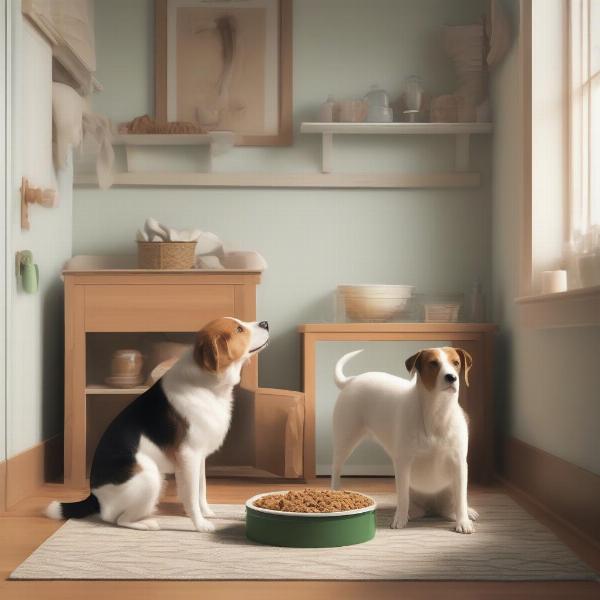Let the big dog eat GIF often depicts a larger dog getting first dibs on food, sometimes gently nudging a smaller dog aside. This resonates with many dog owners who observe similar dynamics within their multi-dog households. While a funny GIF, it touches upon a serious topic: canine feeding hierarchy and how it impacts mealtimes. This article dives into the nuances of this hierarchy, providing practical advice for managing mealtimes in multi-dog homes, promoting a peaceful dining experience for all your furry companions.
Understanding Canine Feeding Hierarchy
In the wild, canine packs often have a social structure that dictates access to resources, including food. This isn’t always a rigid, aggressive system as often depicted. Sometimes, it’s a subtle dance of deference, where younger or more submissive dogs naturally yield to more senior or confident members. This translates to domestic settings, where one dog might consistently finish their food first, or wait for the other dog to finish before approaching their own bowl. This doesn’t necessarily mean aggression; it could simply be a learned behavior or a sign of respect within their established dynamic.
Managing Mealtimes in a Multi-Dog Home
Creating a harmonious dining experience involves understanding and respecting your dogs’ individual personalities and their established dynamic. While letting the “big dog eat” might seem natural, it’s essential to ensure all dogs are getting enough to eat and feeling safe during mealtimes.
Separate Feeding Areas
Providing separate feeding stations is crucial. This gives each dog a sense of personal space and reduces competition. Choose different areas of the room, or even different rooms altogether. This helps avoid resource guarding, where a dog becomes protective of their food bowl.
Supervised Mealtimes
Initially, supervise mealtimes to observe any tension or resource guarding. Even if your dogs typically get along, mealtimes can trigger a different dynamic. Your presence can reassure them and prevent any potential conflicts.
Equal Portions & Balanced Nutrition
Ensure each dog receives an appropriate portion of food based on their age, breed, and activity level. A balanced diet is crucial for their overall health and can influence behavior. dog bone stocking can be a great treat for positive reinforcement during mealtime training.
 Separate Dog Feeding Stations
Separate Dog Feeding Stations
Addressing Food Aggression
While some level of deference is normal, outright food aggression requires intervention. Signs of food aggression include growling, snapping, or lunging at other dogs while eating. This behavior can escalate and needs to be addressed promptly.
Professional Guidance
If you observe food aggression, consult a certified dog trainer or veterinary behaviorist. They can assess the situation and provide tailored strategies to address the underlying cause of the aggression. This might involve desensitization and counter-conditioning techniques.
Gradual Desensitization
This involves slowly introducing the dogs to each other’s presence during mealtimes, starting with a significant distance and gradually decreasing it as they become more comfortable. dog bed sale can be used to create comfortable individual spaces during this process.
Conclusion
The “let the big dog eat GIF” highlights a common observation in multi-dog homes, but understanding the nuances of canine feeding hierarchy is essential. By implementing strategies like separate feeding areas, supervised mealtimes, and addressing food aggression promptly, we can ensure a positive and stress-free dining experience for all our furry companions. A peaceful mealtime contributes significantly to a harmonious multi-dog household. dog swing can be a great reward after a successful, peaceful mealtime.
FAQ
- Why does my older dog growl at my puppy when eating? This is often a display of resource guarding, asserting dominance or protecting their food.
- Is it okay to feed my dogs from the same bowl? Generally, it’s not recommended, as it can increase competition and trigger resource guarding.
- What should I do if my dog steals food from another dog’s bowl? Separate feeding areas and supervised mealtimes are essential to prevent this.
- How can I introduce a new dog to a household with an established feeding routine? Introduce them gradually and ensure separate feeding stations from the start.
- Is food aggression always a sign of dominance? Not necessarily. It can stem from fear, anxiety, or past experiences with food scarcity.
- Can puppies exhibit food aggression? Yes, even puppies can display food guarding behaviors. Early intervention is important.
- How long does it take to address food aggression? This varies depending on the severity and the individual dog. Consistency and patience are key.
Further Reading
For more information on dog behavior and training, check out these helpful resources:
About ILM Dog
ILM Dog is your trusted resource for expert advice on all aspects of dog care, from breed selection and puppy care to senior dog health and training. We provide practical, evidence-based information to help you navigate every stage of your dog’s life. Whether you’re a seasoned dog owner or just starting your journey, we offer valuable insights into nutrition, behavior, health, grooming, and product recommendations. We are passionate about promoting the well-being of dogs worldwide and providing a supportive community for dog lovers. Contact us at [email protected] or +44 20-3965-8624 for personalized advice and guidance.